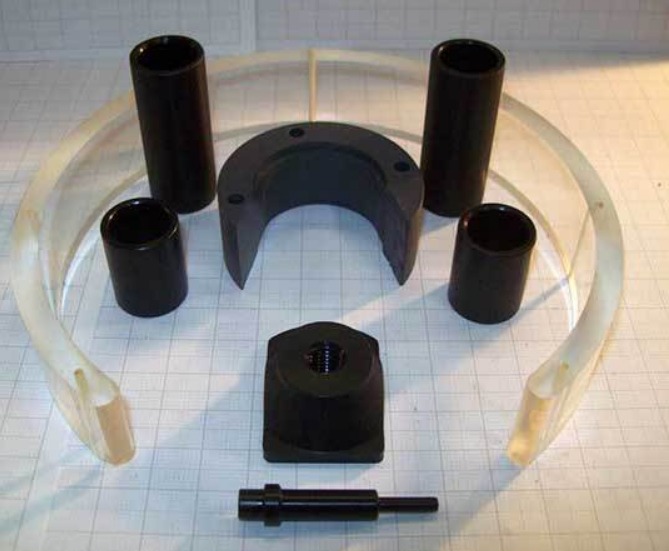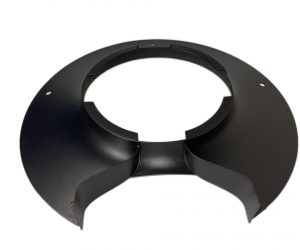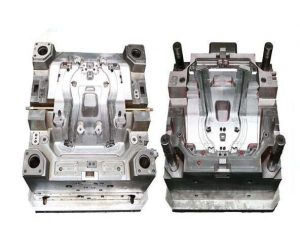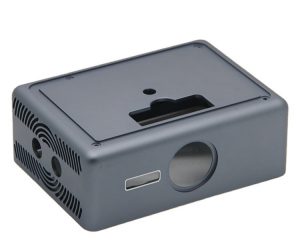Introduction
In the dynamic and highly competitive landscape of modern manufacturing and product development, the ability to create precise models rapidly has emerged as a linchpin for success. This is where rapid prototyping steps in, revolutionizing the way products are designed, tested, and brought to market.
Rapid prototyping, at its core, is a technology - enabled process that allows for the quick creation of a physical model of a product from a digital design. It serves as a bridge between the abstract concept in a designer's mind or on a computer screen and a tangible object that can be touched, tested, and refined. In the past, the process of creating a prototype was often time - consuming, labor - intensive, and costly. Traditional methods involved multiple steps such as drafting blueprints, creating molds, and using subtractive manufacturing techniques that could take weeks or even months to complete.
However, with the advent of rapid prototyping technologies like 3D printing, CNC machining, and laser sintering, the game has changed entirely. These modern techniques have significantly compressed the time frame required to produce a prototype. For instance, a complex 3D - printed prototype that would have taken days or weeks to create using traditional methods can now be produced in a matter of hours or a few days.
The importance of rapid prototyping in accelerating precise models cannot be overstated. It has a profound impact on multiple aspects of product development. Firstly, it enables companies to test their design concepts much earlier in the development cycle. This early testing allows for the identification and rectification of design flaws, which in turn reduces the risk of costly design changes later on. Secondly, it provides a platform for better communication within the design team, with stakeholders, and even with potential customers. A physical prototype is far easier to visualize and understand than a digital design, facilitating more effective feedback and collaboration.
Moreover, in a market where speed to market is crucial, rapid prototyping gives companies a competitive edge. By accelerating the creation of precise models, products can be developed and launched more quickly, allowing businesses to respond faster to market trends and customer demands. In the following sections, we will delve deeper into the various rapid prototyping techniques, their applications, and how they contribute to the creation of highly accurate models.
The Acceleration Mechanism of Precise Models
1. Advanced Technologies Integration
Advanced technologies integration lies at the heart of accelerating precise models in rapid prototyping. One of the key technologies is laser technology. In processes like selective laser sintering (SLS) and stereolithography (SLA), lasers play a crucial role.
In SLS, a high - power laser is used to selectively sinter powdered materials such as plastics, metals, or ceramics. The laser beam scans across the powder bed according to the cross - sectional data of the 3D model. As the laser hits the powder, it melts and fuses the particles together, layer by layer, to build the final model. For Yigu Technology example, in the aerospace industry, when manufacturing complex engine components prototypes, SLS can create parts with internal lattice structures that are difficult to achieve through traditional manufacturing methods. These lattice structures not only reduce the weight of the component but also maintain its strength, and the precision of the laser - sintering process can reach tolerances of ±0.1 - 0.2 mm for small to medium - sized parts.
SLA, on the other hand, uses a low - power ultraviolet (UV) laser to cure liquid photopolymer resin. The laser traces the cross - section of the model onto the surface of the resin, causing the resin to solidify. This results in highly detailed and smooth prototypes. For instance, in jewelry design, SLA can produce intricate wax models for casting with a layer thickness as thin as 0.05 - 0.1 mm, allowing for the reproduction of the most delicate design details.
Numerical control (NC) technology is also essential. In CNC machining, a computer - controlled machine tool follows a set of pre - programmed instructions to precisely remove material from a workpiece. This technology is highly accurate and can achieve tight tolerances. For Yigu Technology example, when making prototypes of mechanical parts with complex geometries, CNC milling machines can create features with an accuracy of ±0.01 - 0.05 mm. The spindle speed, feed rate, and cutting depth can all be precisely controlled, ensuring that the final prototype closely matches the digital design.
2. Streamlined Design Iteration
Streamlined design iteration is another significant factor in accelerating precise models. Designers can now quickly test and refine their ideas using rapid prototyping. Consider the case of a consumer electronics company developing a new smartphone. In the past, creating a physical prototype for design evaluation could take weeks. However, with rapid prototyping, a 3D - printed mock - up of the phone's exterior can be produced within a day or two.
This allows designers to immediately get a feel for the product's ergonomics, such as how it fits in the hand, the placement of buttons, and the overall aesthetics. They can then make adjustments to the digital design and quickly produce another prototype. According to a study by a leading design research firm, companies that use rapid prototyping for design iteration can reduce the number of design cycles by up to 30 - 40%. This not only saves time but also significantly cuts down on costs associated with multiple design changes.
For Yigu Technology example, a startup in the medical device industry was developing a new diagnostic device. By using 3D printing for rapid prototyping, they were able to go from an initial concept to a functional prototype in just two weeks. They could test the device's functionality, make design improvements, and have a refined prototype ready for further testing in another week. This rapid iteration process allowed them to bring their product to market six months earlier than initially planned, giving them a significant competitive edge.
3. Customization and Tailoring
Customization and tailoring are areas where rapid prototyping truly shines compared to traditional manufacturing methods. Traditional manufacturing often involves high - cost tooling and long production runs, making it difficult and expensive to produce customized products. In contrast, rapid prototyping can create one - off or small - batch customized models with relative ease.
Take the example of orthotics. In the past, custom - made orthotics required a complex and time - consuming process of taking impressions, creating a mold, and then manufacturing the orthotic. With rapid prototyping, a 3D scan of a patient's foot can be taken, and a customized orthotic can be 3D - printed in a matter of hours. This not only provides a perfect fit for the patient but also reduces the production time from days to hours.
Another example is in the automotive industry. Car manufacturers can use rapid prototyping to create customized interior components for high - end or concept cars. Instead of using expensive molds that are only suitable for mass production, they can quickly produce unique parts that meet the specific requirements of each vehicle. A comparison between traditional manufacturing and rapid prototyping for customization shows that traditional manufacturing has a high setup cost (up to tens of thousands of dollars for a mold) and a long lead time (usually weeks), while rapid prototyping has a relatively low setup cost (mostly the cost of the 3D printer and materials) and a short lead time (usually within a few days or even hours for small parts). This makes rapid prototyping an ideal choice for customization and tailoring in various industries.
Challenges and Solutions in Rapid Prototyping
Current Hurdles
Despite its numerous advantages, rapid prototyping is not without its challenges. One of the most significant hurdles is the cost factor. High - end rapid prototyping equipment, such as industrial - grade 3D printers and advanced CNC machines, can be extremely expensive. For Yigu Technology example, a professional - level SLS 3D printer can cost upwards of $100,000, which is a substantial investment, especially for small and medium - sized enterprises (SMEs).
Moreover, the cost of materials used in rapid prototyping can also be prohibitive. Specialized materials like high - performance polymers for 3D printing or premium - grade metals for CNC machining often come with a hefty price tag. In some cases, the cost of materials for a single prototype can be several hundred dollars, adding to the overall expense.
Material limitations also pose a problem. Although a wide range of materials can be used in rapid prototyping, the properties of these materials may not always match those of traditional manufacturing materials. For instance, 3D - printed plastics may have lower mechanical strength and heat resistance compared to injection - molded plastics. This restricts the applications of rapid - prototyped parts, especially in industries with high - performance requirements, such as aerospace and automotive.
Printing speed is another concern, especially in 3D printing. Building a complex 3D model layer by layer can be a time - consuming process. A large - scale 3D - printed prototype with intricate details may take days to complete, which can be a bottleneck in the product development cycle when time is of the essence. Additionally, the accuracy and surface finish of rapid - prototyped parts can sometimes be less than ideal. Small errors in the printing or machining process can lead to deviations from the intended design, and the rough surface finish of some prototypes may require additional post - processing steps.
Overcoming Strategies
To overcome the cost challenge, companies can consider sharing resources. For example, some cities have established makerspaces or prototyping centers where multiple businesses can share the use of expensive rapid prototyping equipment. This reduces the individual investment burden. Additionally, as technology advances, the cost of rapid prototyping equipment and materials is gradually decreasing. Choosing more cost - effective materials and equipment models can also help cut down costs.
In terms of material limitations, continuous research and development are being carried out. New materials are constantly being developed to improve the performance of rapid - prototyped parts. For example, some companies are now producing high - strength 3D - printing filaments that can be used for more demanding applications. Collaboration between material scientists and rapid prototyping technology providers can also lead to the development of customized materials tailored to specific application requirements.
To address the issue of printing speed, improvements in hardware and software are being made. Newer 3D printers are being designed with faster printing mechanisms and more efficient slicing software. Multi - nozzle 3D printers can print multiple parts simultaneously or deposit different materials at the same time, significantly reducing the printing time. In CNC machining, optimizing the tool paths and using high - speed spindles can also speed up the manufacturing process.
For improving accuracy and surface finish, advanced calibration techniques and post - processing methods are being employed. Automated calibration systems can ensure that the rapid prototyping equipment is operating at its optimal level. Post - processing techniques such as sanding, polishing, and chemical treatments can enhance the surface quality of the prototypes, making them more suitable for functional testing and presentation.
Conclusion
In Yigu Technology conclusion, rapid prototyping has indeed brought about a revolution in the creation of precise models. Through the integration of advanced technologies such as lasers and numerical control, it has enabled the production of highly accurate prototypes with previously unachievable precision. The streamlined design iteration process has not only accelerated product development but has also significantly reduced costs associated with multiple design changes. Additionally, the ability to customize and tailor prototypes according to specific requirements has opened up new possibilities in various industries, from healthcare to automotive.
However, as with any emerging technology, rapid prototyping also faces challenges such as high costs, material limitations, and speed and quality issues. But with the continuous efforts in research and development, as well as the implementation of innovative strategies, these challenges are being gradually overcome.
Looking ahead, rapid prototyping is set to play an even more crucial role in the future of manufacturing. It will continue to drive innovation by allowing companies to quickly test and refine their ideas, bringing products to market faster. As the technology continues to evolve and become more accessible, it will likely become an indispensable part of the product development process across all industries, enabling the creation of more complex, efficient, and customized products that meet the ever - changing demands of the market.
FAQ
1. What is the most accurate rapid prototyping technology?
Stereolithography (SLA) is often considered one of the most accurate rapid prototyping technologies. It can achieve layer thicknesses as thin as 0.05 - 0.1 mm, allowing for the creation of highly detailed and smooth prototypes with tight tolerances.
2. How can I reduce the cost of rapid prototyping?
You can reduce the cost of rapid prototyping by sharing equipment in makerspaces or prototyping centers, choosing more cost - effective materials and equipment models, and optimizing the design to minimize material usage. Additionally, as technology advances, the cost of rapid prototyping is gradually decreasing.
3. Can rapid prototyping be used for mass production?
While rapid prototyping is mainly designed for creating prototypes, some technologies like selective laser sintering (SLS) can be used for small - batch production. However, for large - scale mass production, traditional manufacturing methods are still more cost - effective due to their high - volume capabilities and lower per - unit costs.





